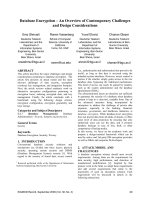An overview of Cplusplus
Bạn đang xem bản rút gọn của tài liệu. Xem và tải ngay bản đầy đủ của tài liệu tại đây (548.4 KB, 35 trang )
AN OVERVIEW OF
C++
1
OBJECTIVES
Introduction
What is object-oriented programming?
Two versions of C++
C++ console I/O
C++ comments
Classes: A first look
Some differences between C and C++
Introducing function overloading
C++ keywords
Introducing Classes
2
INTRODUCTION
C++ is the C programmer’s answer to
Object-Oriented Programming (OOP).
C++ is an enhanced version of the C
language.
C++ adds support for OOP without
sacrificing any of C’s power, elegance, or
flexibility.
C++ was invented in 1979 by Bjarne
Stroustrup at Bell Laboratories in Murray
Hill, New Jersey, USA.
3
INTRODUCTION (CONT.)
The elements of a computer language do not exist
in a void, separate from one another.
The features of C++ are highly integrated.
Both object-oriented and non-object-oriented
programs can be developed using C++.
4
WHAT IS OOP?
OOP is a powerful way to approach the
task of programming.
OOP encourages developers to decompose
a problem into its constituent parts.
Each component becomes a self-contained
object that contains its own instructions
and data that relate to that object.
So, complexity is reduced and the
programmer can manage larger programs.
5
WHAT IS OOP? (CONT.)
All OOP languages, including C++, share
three common defining traits:
Encapsulation
Binds together code and data
Polymorphism
Allows one interface, multiple methods
Inheritance
Provides hierarchical classification
Permits reuse of common code and data
6
TWO VERSIONS OF C++
A traditional-style C++ program -
7
#include <iostream.h>
int main()
{
/* program code */
return 0;
}
TWO VERSIONS OF C++ (CONT.)
A modern-style C++ program that uses the new-
style headers and a namespace -
8
#include <iostream>
using namespace std;
int main()
{
/* program code */
return 0;
}
THE NEW C++ HEADERS
The new-style headers do not specify filenames.
They simply specify standard identifiers that
might be mapped to files by the compiler, but
they need not be.
<iostream>
<vector>
<string>, not related with <string.h>
<cmath>, C++ version of <math.h>
<cstring>, C++ version of <string.h>
Programmer defined header files should end in
“.h”.
9
SCOPE RESOLUTION OPERATOR
(::)
Unary Scope Resolution Operator
Used to access a hidden global variable
Example: usro.cpp
Binary Scope Resolution Operator
Used to associate a member function with its
class (will be discussed shortly)
Used to access a hidden class member variable
(will be discussed shortly)
Example: bsro.cpp
10
NAMESPACES
A namespace is a declarative region.
It localizes the names of identifiers to avoid name
collisions.
The contents of new-style headers are placed in
the std namespace.
A newly created class, function or global variable
can put in an existing namespace, a new
namespace, or it may not be associated with any
namespace
In the last case the element will be placed in the global
unnamed namespace.
Example: namespace.cpp
11
C++ CONSOLE I/O (OUTPUT)
cout << “Hello World!”;
printf(“Hello World!”);
cout << iCount; /* int iCount */
printf(“%d”, iCount);
cout << 100.99;
printf(“%f”, 100.99);
cout << “\n”, or cout << ‘\n’, or cout <<
endl
printf(“\n”)
In general, cout << expression;
12
Do we smell polymorphism here???
cout ???
Shift right operator ???
How does a shift right
operator produce output
to the screen?
C++ CONSOLE I/O (INPUT)
cin >> strName; /* char strName[16] */
scanf(“%s”, strName);
cin >> iCount; /* int iCount */
scanf(“%d”, &iCount);
cin >> fValue; /* float fValue */
scanf(“%f”, &fValue);
In general, cin >> variable;
13
Hmmm. Again polymorphism.
C++ CONSOLE I/O (I/O CHAINING)
cout << “Hello” << ‘ ‘ << “World” << ‘!’;
cout << “Value of iCount is: ” << iCount;
cout << “Enter day, month, year: ”;
cin >> day >> month >> year;
cin >> day;
cin >> month;
cin >> year
14
What’s actually happening here? Need to learn more.
C++ CONSOLE I/O (EXAMPLE)
15
include <iostream>
int main()
{
char str[16];
std::cout << “Enter a
string: ”;
std::cin >> str;
std::cout << “You entered:
” << str;
}
include <iostream>
using namespace std;
int main()
{
char str[16];
cout << “Enter a string: ”;
cin >> str;
cout << “You entered: ”
<< str;
}
C++ COMMENTS
Multi-line comments
/* one or more lines of comments */
Single line comments
// …
16
CLASSES: A FIRST LOOK
General syntax -
17
class class-name
{
// private functions and variables
public:
// public functions and variables
}object-list (optional);
CLASSES: A FIRST LOOK (CONT.)
A class declaration is a logical abstraction
that defines a new type.
It determines what an object of that type
will look like.
An object declaration creates a physical
entity of that type.
That is, an object occupies memory space,
but a type definition does not.
Example: p-23.cpp, p-26.cpp, stack-test.c.
18
CLASSES: A FIRST LOOK (CONT.)
Each object of a class has its own copy of every
variable declared within the class (except static
variables which will be introduced later), but
they all share the same copy of member
functions.
How do member functions know on which object they
have to work on?
The answer will be clear when “this” pointer is introduced.
19
SOME DIFFERENCES
BETWEEN C AND C++
No need to use “void” to denote empty parameter
list.
All functions must be prototyped.
If a function is declared as returning a value, it
must return a value.
Return type of all functions must be declared
explicitly.
Local variables can be declared anywhere.
C++ defines the bool datatype, and keywords
true (any nonzero value) and false (zero).
20
INTRODUCING FUNCTION
OVERLOADING
Provides the mechanism by which C++ achieves one
type of polymorphism (called compile-time
polymorphism).
Two or more functions can share the same name as
long as either
The type of their arguments differs, or
The number of their arguments differs, or
Both of the above
21
INTRODUCING FUNCTION
OVERLOADING (CONT.)
The compiler will automatically select the correct
version.
The return type alone is not a sufficient
difference to allow function overloading.
Example: p-34.cpp, p-36.cpp, p-37.cpp.
22
Q. Can we confuse the compiler with
function overloading?
A. Sure. In several ways. Keep exploring C++.
C++ KEYWORDS (PARTIAL LIST)
23
bool
catch
delete
false
friend
inline
namespace
new
operator
private
protected
public
template
this
throw
true
try
using
virtual
wchar_t
INTRODUCING
CLASSES
24
CONSTRUCTORS
Every object we create will require some sort of
initialization.
A class’s constructor is automatically called by the
compiler each time an object of that class is created.
A constructor function has the same name as the
class and has no return type.
There is no explicit way to call the constructor.
25









